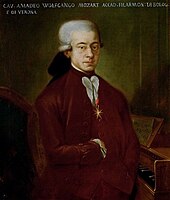Order of the Golden Spur
The Order of the Golden Spur , originally the Order of the Golden Militia (Ordo Equestris Militiae Auratae), is the second highest order for services to the Roman Catholic Church . It is awarded directly by the Pope . One seldom reads the terms Order of the Golden Spur and Order of the Golden Spur ; the official name is Ordine dello Speron d'Oro , also Ordine della Milizia Aurata .
The name of the bearer of the Knight of the Golden Spur should not be confused with the Knight of the Golden Spur .
Creation and award

The Order of the Golden Spur is today an award limited to 100 members. In the period from 1558 to 1759 the order was not only awarded by the Pope, but also by higher Italian nobles. The award was mainly given to artists and architects who were to be honored for their services to the Catholic Church. Associated with this was an appointment as Papal Count Palatinate (Comes palatinus Lateranus). An example of this is the Brandenburg 1st court architect Christian Eltester , who was awarded the medal by the Duke Comitibus Sforza in 1694 for helping to renovate the papal Palazzo Montecitorio (today's seat of the Italian Parliament). This practice was restricted in 1815 and in 1841 under Pope Gregory XVI. then canceled.
At a red ribbon that on a stylized golden depends Armor fortified Maltese cross with an attached golden spur. It developed from a badge of the order of knights , but the donor and the year of the foundation are not known.
The form of the award now valid was determined by the reform of Pope Pius X on February 7, 1905. The order is only available in one class. The cross is no longer worn on a red ribbon, but on a gold collar; The breast star studded with diamonds has also been added.
Both laypeople and clergy can receive the Order of the Golden Spur on the basis of personal merit and within the framework of diplomatic practice, even for non-Christians.
Position within the hierarchy
The following ranking of the papal orders of merit and decorations applies:
- Order of Christ (confirmed by John XXII in 1319, renewed by Pius X in 1905 ) (only one class, usually only to heads of state)
- Order of the Golden Spur
- Order of Pius (donated by Pius IX in 1847 ) (four classes)
- Order of Saint Gregory (donated by Gregory XVI in 1831 ) (four classes)
- New Year's Eve Order (donated by Gregory XVI in 1841) (four classes)
- Pro Ecclesia et Pontifice (donated by Leo XIII in 1888 ; Cross of Merit, only one class)
- Benemerenti (donated by Gregory XVI in 1832; Medal of Merit, only one class)
- Jerusalem Pilgrim Cross (donated by Leo XIII in 1901) (three classes)
Known knights
Privileges
The knights of the Order of the Golden Spur were entitled to use the title Cavaliere vom Spur and were addressed in letters with Sacri Palatii Comites et Equites aurati . Cavaliers were allowed (and still are allowed to) ride into a church on horseback. Cavaliere was translated into German as “knight”, but of the three recipients named Gluck, Mozart and Dittersdorf, only the first made use of this designation.
Awarded by the Dukes of Sforza
Pope Paul III (1468–1549) granted his nephews, the dukes of Sforza , counts of Santa Fiora and their descendants, the privilege of "appointing knights of the golden spur" in 1539 . The title they awarded was at times available for little money and was not well respected.
See also
literature
- The medals and decorations of Konrad Adenauer. ed. by Gustav Andreas Tammann and Engelbert Hommel on behalf of the Bundeskanzler-Adenauer-Haus Foundation, Gottschalk-Graphik, Bad Honnef 1999, ISBN 3-9806090-1-4 , pp. 90–93. [Description of the history of the Order of the Golden Spur and its award, with illus.]
Individual evidence
- ↑ C. Muguardt: The book of orders of knights and decorations . 1848, p. 121ff.

